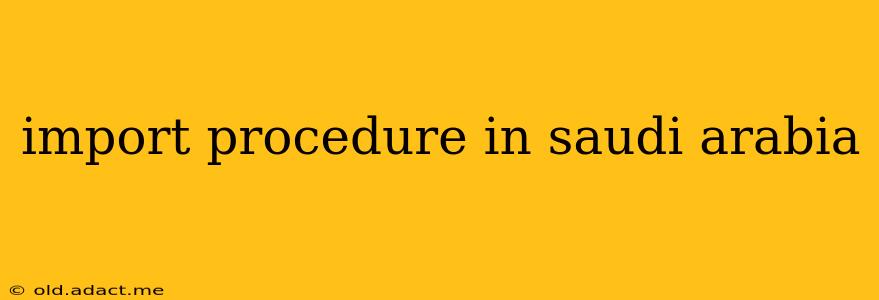Importing goods into Saudi Arabia can seem daunting, but with careful planning and understanding of the regulations, the process can be streamlined. This guide provides a comprehensive overview of the import procedure, addressing common questions and concerns. This information is for guidance only and should not be considered legal advice. Always consult with relevant authorities and professionals for the most up-to-date and accurate information.
What are the main steps involved in importing goods into Saudi Arabia?
The import process generally involves these key steps:
-
Market Research & Product Selection: Thorough research is crucial. Understand Saudi Arabian market demands, competition, and any specific regulations for your product category.
-
Finding a Reliable Supplier: Select a reputable supplier who can meet your quality and delivery requirements. Ensure they understand Saudi Arabian import regulations.
-
Obtaining Necessary Licenses and Permits: This is a critical stage. Different products require different licenses and permits from various Saudi Arabian government agencies, including the Saudi Customs Authority (SCA). These often include import licenses, product registration certificates (depending on the product type), and potentially others based on industry specifics.
-
Customs Documentation: Accurate and complete documentation is essential for smooth customs clearance. Required documents typically include:
- Commercial Invoice
- Packing List
- Bill of Lading (for sea freight) or Airway Bill (for air freight)
- Certificate of Origin
- Any relevant permits or licenses
-
Customs Clearance: Once your shipment arrives at a Saudi Arabian port, it will undergo customs inspection. Having all necessary documentation in order significantly speeds up this process. A customs broker can assist in navigating this stage.
-
Payment and Delivery: After customs clearance, you'll make the final payment to your supplier (often through a Letter of Credit) and arrange for the delivery of your goods to your destination within Saudi Arabia.
-
Post-Import Compliance: Ensure compliance with any post-import regulations, such as product labeling requirements or ongoing reporting obligations.
What are the import regulations and requirements in Saudi Arabia?
Saudi Arabia's import regulations are comprehensive and aim to protect consumers and national interests. Regulations vary significantly depending on the type of goods being imported. Some key considerations include:
- Prohibited Goods: Certain goods are completely prohibited from import, including narcotics, weapons, and certain publications.
- Restricted Goods: Many other goods require special permits or licenses before import, such as food products, pharmaceuticals, and electronics.
- Standards and Specifications: Imported goods must meet specific Saudi Arabian standards and specifications, often relating to safety, quality, and labeling. The Saudi Standards, Metrology and Quality Organization (SASO) plays a critical role in this area. SASO certification is frequently required.
- Customs Duties and Taxes: Imported goods are subject to various duties and taxes, including customs duties, value-added tax (VAT), and potentially other levies.
What documents are needed for importing goods into Saudi Arabia?
As mentioned earlier, thorough documentation is essential. The exact documents required will vary based on the product, but typically include:
- Commercial Invoice: A detailed invoice showing the transaction details between buyer and seller.
- Packing List: A precise list of the contents of each package.
- Bill of Lading (or Airway Bill): A document of title issued by the carrier.
- Certificate of Origin: Verifies the origin of the goods.
- SASO Certificate (if required): Indicates compliance with Saudi Arabian standards.
- Import License (if required): Authorizes the import of specific goods.
- Other Permits or Licenses: Any other specific permits or licenses needed for the product.
What is the role of a customs broker in Saudi Arabia?
A customs broker can be invaluable in navigating the complexities of Saudi Arabian import regulations. They can:
- Assist with obtaining necessary licenses and permits.
- Prepare and submit the required documentation.
- Manage customs clearance procedures.
- Ensure compliance with all regulations.
- Handle any disputes or issues that may arise.
How long does the import process take in Saudi Arabia?
The duration of the import process varies depending on several factors, including:
- The type of goods being imported.
- The completeness and accuracy of the documentation.
- The efficiency of customs procedures.
- Any unforeseen delays.
Generally, expect the process to take several weeks, and potentially longer in some cases.
What are the costs associated with importing goods into Saudi Arabia?
Import costs include:
- Supplier Costs: The cost of the goods from the supplier.
- Shipping Costs: Freight costs, insurance, and handling charges.
- Customs Duties and Taxes: Various duties, VAT, and other potential levies.
- Customs Broker Fees: Fees paid to a customs broker for their services.
- Other Costs: Potential storage fees, inspection fees, and other miscellaneous expenses.
Careful budgeting is essential to account for all potential costs.
This guide provides a general overview. For specific information related to your product and circumstances, refer to official Saudi Arabian government websites and consult with relevant authorities and professionals for accurate and updated information.
